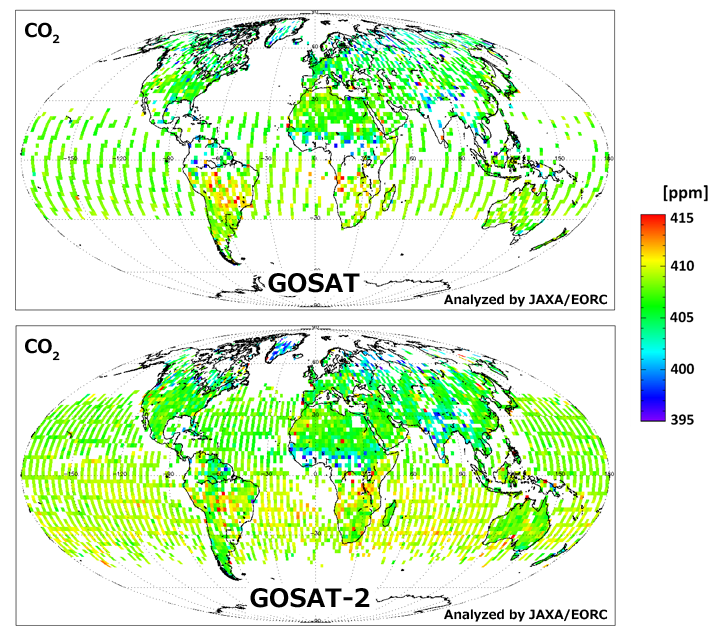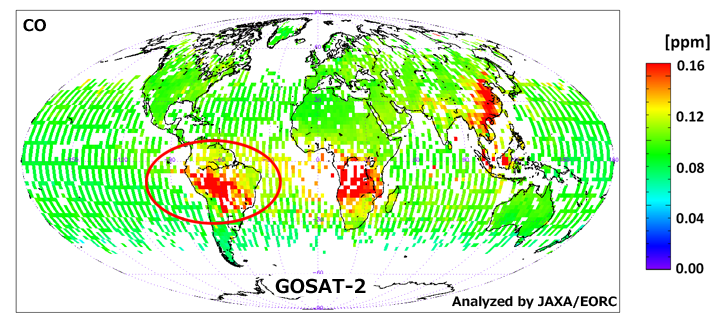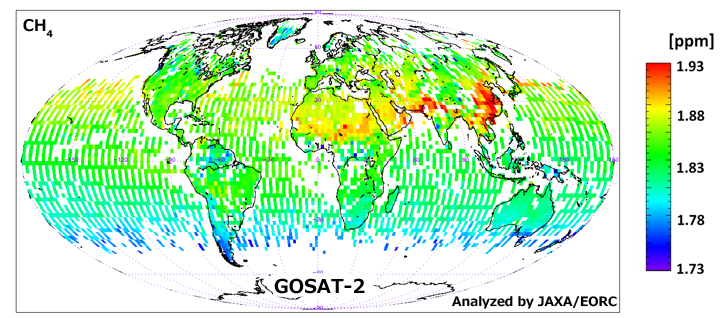

Meteorology and the Environment
2020.02.03 Mon
Long-term observation of greenhouse gasses in order to realize the Paris Agreement∼A first Analysis of global CO2 distribution observed by GOSAT-2∼
JAXA/EORC has retrieved the global distribution of greenhouse gas concentration from radiance spectra acquired from Greenhouse gases Observing SATellite-2 GOSAT-2. GOSAT-2 is a successor of GOSAT, which has been operational for more than 11 years since 2009. In order to contribute to the Paris Agreement, long-term observations of greenhouse gasses are indispensable. In complement with its predecessor, GOSAT-2 would enable such continuous monitoring.
* GOSAT-2: Launched in 2018 as a joint project from the Ministry of Environment, the National Institute for Environmental Studies and JAXA.
As successor to GOSAT (extended mission life), GOSAT-2 was launched in October 2018. It aims to realize long-term monitoring of greenhouse gasses and contribute to the environmental administrations and the international actions to control global warming. GOSAT-2 has improved observation capabilities by measuring carbon monoxide (CO) in addition to carbon dioxide (CO2) and methane (CH4); observation patterns have also been improved by its improved target-point function.
Since its launch, GOSAT-2 has continued observations successfully. After initial calibration of onboard sensors, radiance spectra by TANSO-FTS-2 and image by TANSO-CAI-2 have been released to the public since August 2019.
We introduce some results regarding global CO2, CH4, and CO distribution obtained by GOSAT-2. As seen in Figure 1, CO2 concentrations observed by GOSAT and GOSAT-2 show good agreement, allowing for long term monitoring with GOSAT-2. By improving its detectivity, GOSAT-2 can retrieve CO2 concentration at regions prior not possible by GOSAT (Figure 1). It also detects CO (Figure 2) and CH4 enhancement from different source sectors by using a two-axis pointing mechanism (Figure 3).
JAXA aims to contribute for the global environmental monitoring and support the Paris Agreement, with joint collaboration with the Ministry of the Environment and the National Institute for Environmental Studies. We are proceeding with data analysis, assessment of large-scale anthropogenic emission reduction and efficacy evaluation towards inventory validation.
To realize the Paris Agreement, a long-term global monitoring of CO2 for more than 10 years is indispensable. By using GOSAT-2, only Japan can achieve observation of CO2 for over 11 years in the world. GOSAT data showed that the average concentration of CO2 in the entire atmosphere had exceeded 400 ppm in December 2015. Figure 1 shows global distribution of CO2 concentrations retrieved from GOSAT and GOSAT-2 data in September 2019. Since CO2 concentrations observed by both at the same spots are well consistent, JAXA can continue to obtain long term data through GOSAT and GOSAT-2 seamlessly. In case of GOSAT, there is a limitation to retrieve CO2 concentration in Africa, Amazon, India, etc. due to thick aerosols in the atmosphere. However, GOSAT-2 is able to retrieve CO2 concentration even in these area by improving its detectivity. It is also possible to observe over oceans with much wider latitudinal range.
In conjunction with GOSAT, GOSAT-2 can monitor CO emitted from combustion in addition to CO2 and CH4. Figure 2 depicts the global distribution of CO concentration retrieved by GOSAT-2 in September 2019. In particular, apparent CO remaining in the atmosphere can be seen over South America due to high concentrations of low temperature combustion during the Amazon forest fires last year.
CH4 is one of the main greenhouse gasses emitted from different source sectors. GOSAT-2 can observe such emissions ranging from human activities, such as electric power plants, large cities, oils and natural gas fields, landfill, livestock and so on. In order to accurately retrieve emission amounts of greenhouse gases, improved pointing capabilities allows for an increase in gas concentration data yields, where designated areas can be prioritized for CH4 monitoring. Figure 3 shows the spatial distribution of CH4 concentration observed by GOSAT-2 in September 2019. It assumes that the higher CH4 distribution is due to mining of oil, coal and natural gas, or wetland.
Explanation of the Images
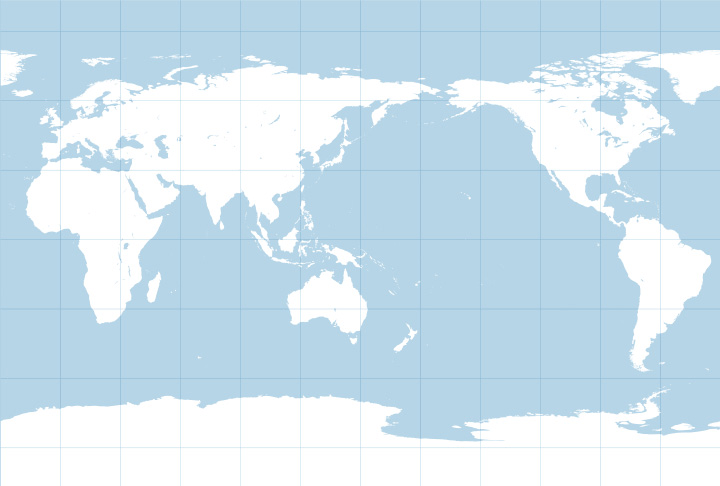
Figure 1.
| Satellite |
Greenhouse gases Observing SATellite GOSAT Greenhouse gases Observing SATellite-2 GOSAT-2 |
|---|---|
| Sensor |
Thermal And Near infrared Sensor for carbon Observations – Fourier Transform Spectrometer (TANSO-FTS) Thermal And Near infrared Sensor for carbon Observations – Fourier Transform Spectrometer – 2 (TANSO-FTS-2) |
| Date | September 2019 |
Figure 2 and 3.
| Satellite | Greenhouse gases Observing SATellite-2 (GOSAT-2) |
|---|---|
| Sensor | Thermal And Near infrared Sensor for carbon Observations – Fourier Transform Spectrometer – 2 (TANSO-FTS-2) |
| Date | September 2019 |
Related Sites
Search by Year
Search by Categories
Tags
-
#Earthquake
-
#Land
-
#Satellite Data
-
#Aerosol
-
#Public Health
-
#GCOM-C
-
#Sea
-
#Atmosphere
-
#Ice
-
#Today's Earth
-
#Flood
-
#Water Cycle
-
#AW3D
-
#G-Portal
-
#EarthCARE
-
#Volcano
-
#Agriculture
-
#Himawari
-
#GHG
-
#GPM
-
#GOSAT
-
#Simulation
-
#GCOM-W
-
#Drought
-
#Fire
-
#Forest
-
#Cooperation
-
#Precipitation
-
#Typhoon
-
#DPR
-
#NEXRA
-
#ALOS
-
#GSMaP
-
#Climate Change
-
#Carbon Cycle
-
#API
-
#Humanities Sociology
-
#AMSR
-
#Land Use Land Cover
-
#Environmental issues
-
#Quick Report
Related Resources
Related Tags
Meteorology and the Environment Related Articles
-
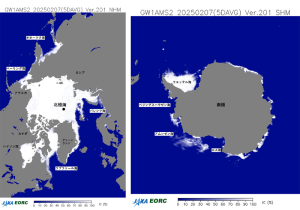 Meteorology and the Environment 2025.05.20 Tue February 2025: Global Sea Ice Extent Reaches its Lowest in the History of Satellite Observations
Meteorology and the Environment 2025.05.20 Tue February 2025: Global Sea Ice Extent Reaches its Lowest in the History of Satellite Observations -
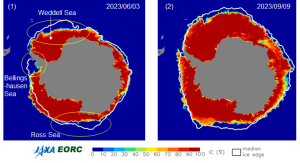 Meteorology and the Environment 2023.10.11 Wed Climate Change 2023 (2) : Antarctic Winter Sea Ice Extent Lowest Ever Recorded
Meteorology and the Environment 2023.10.11 Wed Climate Change 2023 (2) : Antarctic Winter Sea Ice Extent Lowest Ever Recorded -
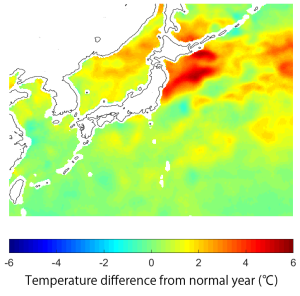 Meteorology and the Environment 2023.08.31 Thu Climate Change 2023 (1) : Sea Surface Temperature Rise and El Niño Event
Meteorology and the Environment 2023.08.31 Thu Climate Change 2023 (1) : Sea Surface Temperature Rise and El Niño Event -
 Meteorology and the Environment 2022.04.28 Thu Antarctic Sea Ice Extent Lowest Ever Recorded
Meteorology and the Environment 2022.04.28 Thu Antarctic Sea Ice Extent Lowest Ever Recorded










